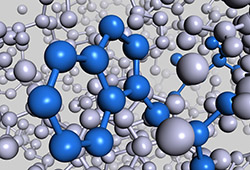
Northwestern Medicine scientists have newly identified a protein’s key role in cell and physiological aging and have developed – in collaboration with Tohoku University in Japan – an experimental drug that inhibits the protein’s effect and prolonged the lifespan in a mouse model of accelerated aging.
The rapidly aging mice fed the experimental drug lived more than four times longer than a control group, and their lungs and vascular system were protected from accelerated aging, the new study reports.
The experimental drug could potentially be used to treat human diseases that cause accelerated aging, such as chronic kidney disease, diabetes and HIV infection as well as the effects of cigarette smoking.
“A drug like this could help reduce complications in clinical conditions that reflect accelerated aging,” said Douglas Vaughan, MD, senior author of the study. “This had a very robust effect in terms of prolonging life span.”
Vaughan is the chair of Medicine and the Irving S. Cutter Professor at Northwestern University Feinberg School of Medicine and physician-in-chief at Northwestern Memorial Hospital.
This is a completely different target and different drug than anything else being investigated for potential effects in prolonging life, Vaughan noted.
While the experimental drug is in the early stages of testing, Vaughan said, “It makes sense that this might be one component of a cocktail of drugs or supplements that a person might take in the future to extend their healthy life.”
The study was published April 28 in Proceedings of the National Academy of Sciences.
The experimental drug, TM5441, is one of only several chosen each year by the National Institute on Aging to be tested in its Interventions Testing Program, which investigates treatments with the potential to extend lifespan and delay disease in mice.
The discovery is the result of 25 years of research by Vaughan’s lab.
When cells or tissue age – called senescence – they lose the ability to regenerate and secrete certain proteins, like a distinctive fingerprint. One of those proteins, PAI-1 (plasminogen activator inhibitor) has been the focus of Vaughan’s research, originally as it relates to cardiovascular disease.
“We made the intellectual leap between a marker of senescence and physiological aging,” Vaughan said. “We asked is this marker for cell aging one of the drivers or mechanisms of rapid physiological aging?”
For the study, he and colleagues used mice bred to be deficient in a gene (Klotho) that suppresses aging. These mice exhibit accelerated aging in the form of arteriosclerosis, neurodegeneration, osteoporosis and emphysema and have much shorter life spans than regular mice. Vaughan determined that these rapidly aging mice produce increased levels of PAI-1 in their blood and tissue.
Then scientists fed the rapidly aging mice TM5441 – the experimental drug – in their food every day. The result was a decrease in PAI-1 activity (the aging protein Vaughan’s team had identified), which quadrupled the mice’s life span and kept their organs healthy and functioning.
Northwestern scientists also genetically produced the same life prolonging results when they crossed the mice deficient in the age-suppressing gene with mice deficient in PAI-1. Importantly, partial genetic deficiency of PAI-1 and the experimental PAI-1 antagonist produced provided similar benefits in the mice, Vaughan noted.
Other Northwestern authors on the study include Mesut Eren, Amanda E. Boe, Sheila B. Murphy, Aaron T. Place, Varun Nagpal, Luisa Morales-Nebreda, Daniela Urich, Susan E. Quaggin, Scott Budinger and Gökhan Mutlu. Dr. Tohio Miyata, the inventor of the experimental drug, TM5441, leads the Center for Translational and Advanced Research, Tohoku University Graduate School of Medicine in Japan and also holds an appointment at Northwestern as an adjunct professor in medicine.
This work was supported by National Heart, Lung and Blood Institute grants 2R01HL051387 and 1P01HL108795 and in part by the National Institute of Diabetes and Digestive and Kidney Diseases grant T32 KD007169, all of the National Institutes of Health.






